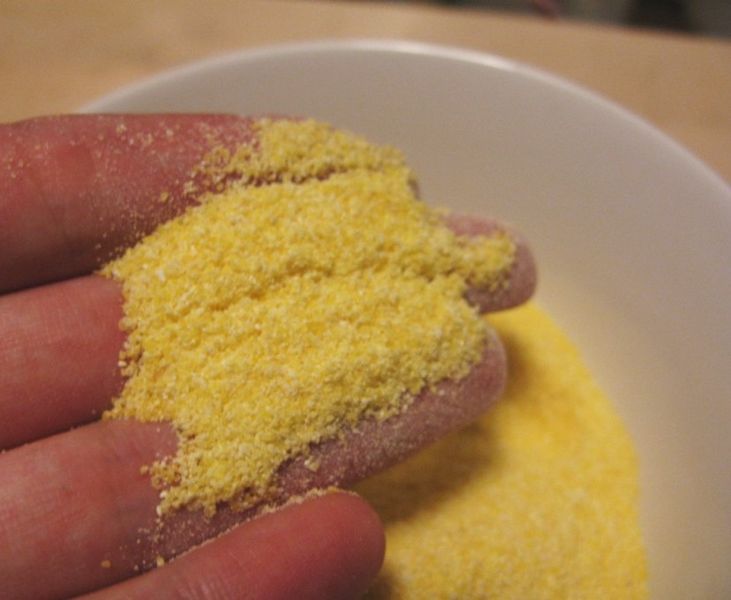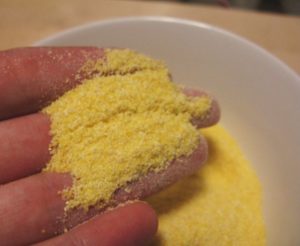Yesterday we did Baking and Spices (dry goods) 1-5. I left out two very important items from the list and I’m going to insert them to the #6 & 7 slot.
6) Corn flour – from http://www.recipetips.com/glossary-term/t–38299/corn-flour.asp
Is a type of flour milled from dried kernels of yellow corn. It is similar to cornmeal except that it is ground to a finer consistency than cornmeal. It is used to make cornbread, muffins, pancakes, polenta, and tortillas. Corn flour is very useful for gluten-free quick breads. Because corn flour contains no gluten, it must be blended with wheat flour when preparing yeasted breads.
There are several other popular varieties of corn flour available and some may be more regionally popular than others. Harinilla is a variety of corn flour made from blue corn. It is often used for a number of Mexican dishes including tortillas, tamales, and dumplings. The blue corn is treated with a lime solution, which expands the kernel, allowing it to be removed from the hull. If harinilla is not available, blue cornmeal can be substituted, but it should be milled in a food processor to produce a flourlike consistency. Harinilla is also known as “blue corn flour” and when it is used for preparing tortillas, it is called “Harina Azul”.
Masa harina is corn flour that is ground from dried hominy. White or yellow corn is used for making hominy, which is also known as “posole” or “pozole”. The corn is boiled in a solution containing powdered lime and is then washed, dried, and ground to form the masa harina. It is used in preparing corn tamales and tortillas. Blue corn is used to make harinilla and is not used for masa harina.
Cornstarch is obtained from the white heart of the corn kernel. Cornstarch is a tasteless, very fine powder that is very useful as a thickener, having double the thickening properties of regular flour. It is widely used for thickening sauces, gravies, and puddings. It is best to stir it into water first before it is added to other foods, so that it can be more easily incorporated without creating lumps. In England, cornstarch is referred to as corn flour or cornflour, while in the United States corn flour refers to whole corn kernels that have been finely ground.
7) Corn Meal
A flour-like substance that has larger granules than regular flour and is produced from grinding dried kernels of yellow or blue corn. Yellow or blue cornmeal can also be ground to a finer consistency and sold as gluten free flour that is used to make cornbread, muffins, pancakes, polenta, and tortillas. Cornmeal is very useful for gluten-free quick breads. Baked goods have a course, gritty texture with a granular crumb and a flavor of sweet corn. Freshly ground cornmeal is best, especially if it is stoneground, because it has more flavor than cornmeal ground using other methods. Because cornmeal contains no gluten, it must be blended with wheat flour in order to form a bread loaf.
Corn Meal when added to a fried food dredge gives a great crunch to the food.
8) Salt
Believe it or not I could go on for a long time about salt. Salt is very important to our bodies and very important to cooking. I would never recommend buying any regular “table salt” ever! Morton’s is the most common table salt. It is fine grained so you tend to use more. It has iodine and aluminum added to it to make it flow and not clumb. Don’t by it for any reason. Instead buy Kosher or Sea salt. You can now find kosher salt in almost every store in the spice department. Pour some into a nice glass open bowl and pinch or spoon from it when you need salt. It has large crystals and a stronger salt taste so you don’t need to use as much. For specialty occasions I use other salts, like black seas salt, pink sea salt, and the ultimate salt in my opinion is Fleur de sel.
“Fleur de sel (“Flower of salt” in French) is a hand-harvested sea salt collected by workers who scrape only the top layer of salt before it sinks to the bottom of large salt pans. Traditional French fleur de sel is collected off the coast of Brittany (most notably in the town of Guérande – Fleur de Sel de Guérande, hand harvested from salt marsh water being the most revered), Noirmoutier, and also Camargue, and is slightly grey due to the sandy minerals collected in the process of harvesting the salt from the pans. Fleur de sel is one of most expensive salts in the world and is usually sold in jars as it is slightly damp.
A great source of all forms of salt that Jughandle highly recommends is www.salttraders.com
Also known in Portuguese as “flor de sal”, the hand-harvested variant from the Algarve region of Portugal is becoming known, as it is of similar quality to the French fleur de sel.[citation needed] In addition, it has the advantage of being pure white and usually sells for half the price of the French fleur de sel.
Fleur de sel is best used similarly to fresh herbs, sprinkling it onto food just before serving” – from Wikipedia
9) Pepper – from http://www.recipezaar.com/library/getentry.zsp?id=337
The world’s most popular spice, a berry grown in grapelike clusters on the pepper plant (a climbing vine native to India and Indonesia. The berry is processed to produce three basic types: black, white, and green. Black is the most common; when picken the berry is not quite ripe, then dried until it shrivels and the skin turns dark brown to black. Black is the strongest (slightly hot with a hint of sweetness) flavor of the three. Tellicherry and Lampong are among the best black peppercorns. White peppercorn, less pungent, has been allowed to ripen, then the skin is removed and the berry dried. White peppercorns are smaller, have a smoother skin and a light-tan color with a milder flavor. The green peppercon is the soft, underripe berry that is usually preserved in brine. It has a fresh flavor that is less pungent than the berry in its other forms.
Ethnicity: India, Indonesia Ingredient
Season: available year-round
How to select: Black and white are available whole, cracked, and ground. Green peppercorns are packed in brine and are available in jars and cans.
How to store: Whole: store in a cool, dark place for about a year. Ground will keep its flavor for about four months. Green peppercorns packed in brine should be refrigerated once opened and will keep for 1 month; packed in water will keep for a week.
How to prepare: Whole peppercorns freshly ground with a pepper mill deliver more flavor than preground.
Matches well with: cheese, eggs, fish, game, lamb, pork, poultry, salad, sausages, soup, steaks, strawberries, tomatoes, veal
You should stock at least both black and white pepper, and you really only need whole corns. Invest in grinder, pepper is always better freshly ground.
10) Sugar
Here we are just talking about white plain sugar. You should have a 5 lb bag around at all times. When you store your flours and sugars it is always good to put them in an airtight container like Tupperware or Rubbermaid. They will keep a long time.
11) Confectioner’s sugar
Sure, this is still sugar but in a completely different form. Known as powdered sugar, 10x sugar, icing sugar, it is all the same except confectioner’s sugar has corn starch added. It is used to make icing, to add as a topping on pancakes, deserts, etc. You really only need a small bag or box unless you are making butter cream icing or fondant. In a pinch you can make powdered sugar by grinding in a blender 1 cup of granulated sugar and 1 tablespoon of corn starch.
12) Brown sugar
Here we go on a very hot topic. I’m going to give you all the info I have on the subject and also tell you that I buy light brown sugar or raw and organic. That way I avoid the chemicals.
Brown sugar is a sucrose sugar product with a distinctive brown color due to the presence of molasses. It is either an unrefined or partially refined soft sugar consisting of sugar crystals with some residual molasses content or produced by the addition of molasses to refined white sugar.
Brown sugar contains from 3.5% molasses (light brown sugar) to 6.5% molasses (dark brown sugar). The product is naturally moist from the hygroscopic nature of the molasses and is often labelled as “soft.” The product may undergo processing to give a product that flows better for industrial handling. The addition of dyes and/or other chemicals may be permitted in some areas or for industrial products. (Jughandle says always read the label)
Particle size is variable but generally less than granulated white sugar. Products for industrial use (e.g. the industrial production of cakes) may be based on caster sugar which has crystals of approximately 0.35 mm.
Manufacturing Process
Many brown sugar producers produce brown sugar by adding cane molasses to completely refined white sugar crystals in order to more carefully control the ratio of molasses to sugar crystals and to reduce manufacturing costs. This also allows the production of brown sugars to be based predominantly on beet sugar. Brown sugar prepared in this manner is often much coarser than its unrefined equivalent and its molasses may be easily separated from the crystals by simple washing to reveal the underlying white sugar crystals; with unrefined brown there is inclusion of molasses within the crystal which will appear off-white if washed. This is mainly done for inventory control and convenience.
The molasses usually used is that obtained from sugar cane, because the flavor is generally preferred over beet sugar molasses. Although in some areas, especially in the Netherlands, sugar beet molasses is used. The white sugar used can be from either beet or cane as odor and color differences will be covered by the molasses.
Brown sugar can be made at home by mixing white granulated sugar with molasses, using one tablespoon of molasses for every cup of white sugar (one-sixteenth or 6.25% of the total volume). Thorough blending will yield dark brown sugar; for light brown sugar, between one and two teaspoons of molasses per cup should be used instead. It is, however, simpler to substitute molasses for an equal portion of white sugar while cooking, without mixing them separately.
When a recipe calls for “brown sugar” it is usually referring to light brown sugar; dark brown sugar should be used only when specified. This is relevant primarily when baking recipes sensitive to moisture and density (such as cakes), because of the difference in moisture content between the two types. In other applications, substituting dark brown sugar over light brown will yield a deeper flavor with more caramel, much like adding molasses would do.
Nutritional value
Brown sugar has a slightly lower caloric value by weight than white sugar due to the presence of water. One hundred grams of brown sugar contains 373 calories, as opposed to 396 calories in white sugar. However, brown sugar packs more densely than white sugar due to the smaller crystal size and may have more calories when measured by volume. One tablespoon of brown sugar has 48 calories against 45 calories for white sugar.
Brown sugar is reputed to have some value as a home remedy for menstrual cramps, though this is likely untrue.
John Yudkin, in his studies (cited in “Pure, White and Deadly” – UK title) that rats fed brown sugar, as opposed to white sugar, suffered all the same ills from such consumption as did the control group fed white sugar, while their offspring did not exhibit the same abnormalities related to the offspring of the rats fed on white sugar. This led to the conclusion that there are some trace nutritional aspects he was unable to detect in brown sugar that made it less harmful than white sugar, though the impact could only be detected in their offspring. Nutritionally, apart from pure carbohydrate, he was not able to detect any nutritional component to white or brown sugar, and such pure carbohydrate is on the list to avoid (therefore the term nutritional is suspect in this case) in the World Health Organization and FAO study on obesity and chronic preventable diseases. Note this study does state that carbohydrates in their intrinsic or unrefined form are nutritionally highly beneficial and should make up 55-75% of our diet, but they are fundamentally different from extrinsic carbohydrates such as both white and brown sugar.
Natural brown sugar is a name for raw sugar which is a brown sugar produced from the first crystallisation of the sugar cane. As such “natural brown sugar” is free of additional dyes and chemicals. There is more molasses in brown sugar, giving it a higher mineral content. Some natural brown sugars have particular names and characteristics, and are sold as Turbinado sugar, Muscovado, or Demerara sugar.
Turbinado sugar is made by crushing freshly cut sugar cane to obtain a juice, which is heated and evaporated to a thick syrup, which is then crystallized. The crystals are then spun in a centrifuge (thus “turbina-“) to remove the excess juice, resulting in the characteristic large, light brown, crystals.
Muscovado (also moscovado) is an unrefined, dark brown sugar that is produced without centrifugation and has much smaller crystals than turbinado sugar. The sugar cane extract is heated to thicken it and then pan-evaporated in the sun and pounded to yield an unprocessed, damp sugar that retains all of the natural minerals.
Demerara (also spelled “demerera”) sugar’s name comes from the Demerera River area of Guyana, where sugar cane was grown. Demerara is another unrefined, centrifuged, large-crystalled, light brown, cane sugar; it is slightly sticky and sometimes molded into sugar cubes. Some Demerara is still produced in South America, but most is now produced in Mauritius, an island off Africa.
That’s good enough for today, here is the revised list of dry goods.
1. baking soda –
2. baking powder
3. Cornstarch
4. yeast
5. flour
6. corn flour
7. corn meal
8. Salt
9. pepper -white and black
10. Sugar
11. confectioner’s sugar
12. brown sugar
13 light corn syrup
14. vanilla extract
15. ground cinnamon
16 whole nutmeg
17. ground cloves
18. powdered ginger
19. dried basil
20. dried oregano
21. chili powder
22. dry mustard
23. paprika
24. thyme
25. tarragon
26. dried dill
27. bay leaves
28. poultry seasoning
29. beef, chicken and vegetable bouillon
30. cream of tartar
31. unseasoned bread crumbs
32. unsweetened cocoa powder
33. unsweetened baking chocolate
34. chocolate chips



1 comment
[…] touched on sugar, mostly brown sugar, in the past “Pantry 101 – Baking and Spices 6-12″ but we just got a question from Debbie in California asking what is the difference […]